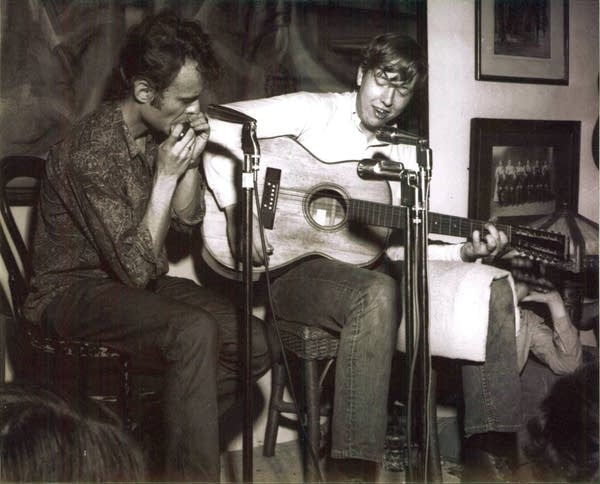Dave Ray's music celebrated with new release

Go Deeper.
Create an account or log in to save stories.
Like this?
Thanks for liking this story! We have added it to a list of your favorite stories.
When harmonica player Tony Glover put together a list of tunes to honor singer Dave Ray, he included several by Lead Belly, the folk and blues musician whose songs and work on the 12-string guitar captivated inspired legions, even if fame came only after his death.
After all, any exploration of Ray's music begins with Lead Belly
When Ray was in high school in Minneapolis, he heard a recording of Lead Belly's performance at the University of Minnesota and it profoundly affected him.
"It was the immediacy of it, the power of it," Ray said in a 1986 interview. "I was just captivated by it. I mean it just knocked my socks off. It's like anything else, you know. It's like readin' some great poet the first time you read it. It just kills ya. You wanna do it, you know. Especially when you're a teenager."
Turn Up Your Support
MPR News helps you turn down the noise and build shared understanding. Turn up your support for this public resource and keep trusted journalism accessible to all.
Ray, who died of cancer in 2002, was best known for being part of the blues trio Koerner, Ray and Glover. But that was just the beginning of a long career in which Ray created an impressive body of music.
On Tuesday, Red House Records will celebrate Ray's music with a new compilation: Rare and Unreleased recordings 1962 to 2002 from an American Blues Master."
The three-CD set, which includes 55 tunes, traces his evolution from an imitator to an interpreter of the blues. Throughout his career, Lead Belly was a key inspiration.
As a teenager, Ray spent all his spare time learning Lead Belly songs... and playing them at a joint called the Coffee Break in Dinkytown. The compilation includes a recording of "Frankie and Albert," one of several Lead Belly tunes that Tony Glover decided to include in the box set.
Glover, who played harmonica with Ray off and on for 40 years, said the selections would have been different if Ray were still alive.
"There are several tunes on the, on the box set that are real faithful Lead Belly reproductions," Glover said. "If he was alive he wouldn't want them on there. He was embarrassed by the kind of minstrel show aspect of it. I mean, that's true to an extent, but it's also amazing that, you know, a white, blond kid who doesn't look old enough to do much of anything is able to get the sound of a southern black guy."
Lead Belly was just the beginning. As a student at the University of Minnesota, Ray teamed up with Glover and John Koerner. They all liked listening to obscure blues records in hopes of finding a hidden gem they could learn to play.
"At the time, that kind of music was sorta mystery music," Glover said. "It wasn't really widely available. You had to really look to find copies of it -- the records anywhere. It was kind of like archeology in a way. We were discovering a music that had been pretty much ignored. The black people had moved beyond it. It was like dated old slave-time music to them. They didn't want anything to do with it. And the white people were listening to white stuff."
Many musicians, including members of the Beatles and the Rolling Stones cite Koerner, Ray and Glover's 1963 album "Blues, Rags and Hollers" as an important influence.
Ray continued performing with Koerner and Glover and others. He also released several solo albums and produced records for other artists including Bonnie Raitt. But unlike most of his contemporaries, Ray never felt compelled to write many original songs. He preferred to keep finding and interpreting old ones.
"The other genius thing that Dave had was the ability to pick out and readapt a tune like 'uncertain blues' which was a Jazz Gillum tune," Glover said. "Jazz Gillum was a so-so harp player but he could write good songs every once in a while. And Dave managed to completely change the tune around and he's got this whole ascending riff thing that goes up the scale between the verses and kind of puts an edge on it that makes it really cook."
Ray never made a lot money playing music. He said he didn't pay much attention to the business side of things. He just liked to play the songs.
In April of 2002 he was diagnosed with lung cancer. Glover said Ray decided against chemotherapy. Instead, his preferred therapy was to play as much, as often and in as many places as possible.
On November 2, 2002, less than a month before his death, Ray performed at the Cedar Cultural Center in Minneapolis.
"It was pretty impressive because Dave was having more and more physical problems at that point," Glover said. "He had stage four cancer and the tumors were growing in his brain and pressing on nerves and affecting his ability to manipulate his hands and so forth. But he kept on pushing. ... People talk about it as being a pretty profound experience."
There will also be a special Dave Ray tribute concert to celebrate the release on Nov. 9 at the Minnesota History Center. Tony Glover, John Koerner, Willie Murphy, Charlie Parr and Ray's brother Max Ray are among the musicians who will be performing.
Dave Ray, A Legacy: CD Release Concert and Celebration
• Date:Nov. 9
• Time: 6-9 p.m.
• Location: Minnesota History Center, 345 Kellogg Blvd., St. Paul
• Tickets: Minnesota History Center


